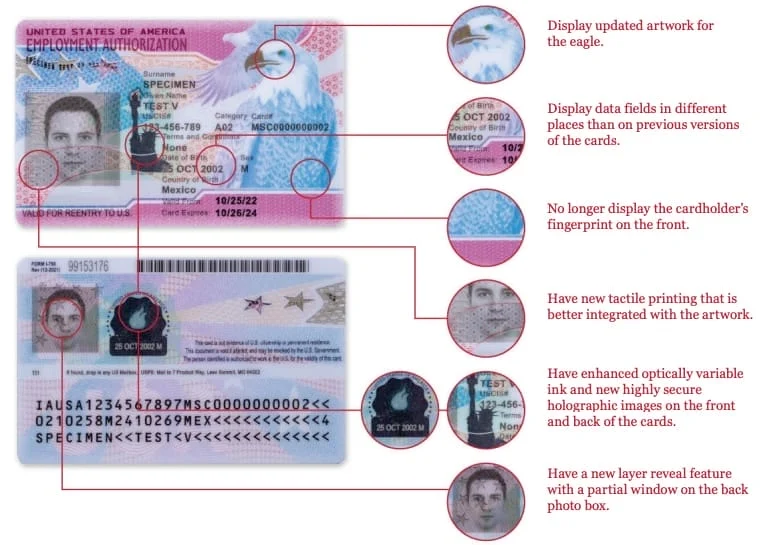Form I-766: Employment Authorization Document (EAD Card), Explained

.svg)
Obtaining legal authorization to work in the United States is an important step for many U.S. immigrants, opening doors to employment opportunities and financial stability. Form I-766 serves as proof that a non-U.S. citizen is allowed to work. This guide explains everything you need to know about Form I-766, from eligibility and application requirements to timelines, costs, and helpful tips.
{{important-1}}

What is Form I-766?
Form I-766 (officially known as the Employment Authorization Document (EAD) and often referred to as a “work permit” or “EAD card”) is an ID card issued by U.S. Citizenship and Immigration Services (USCIS). It proves that a non-U.S. citizen can legally work in the United States. This document serves as both a work permit and valid form of identification.
The I-766 card displays your name, photograph, date of birth, Alien Registration Number, visa classification, and the expiration date of your work authorization. Employers use this card to confirm that you’re authorized to work in the U.S.
{{cta-component-horizontal-aligned}}
EAD Card Benefits
For many immigrants, a work permit is the key to financial independence, career opportunities, and stability in the United States. Benefits of having work authorization include:
- Legal work authorization: The only way many immigrants can legally earn income before becoming lawful permanent residents (green card holders)
- Employment protection: Ensures your right to fair compensation and labor protections without discrimination
- Future immigration security: Working without authorization can jeopardize green card applications and other immigration benefits
- Access to benefits: Required for certain state and federal programs, including health insurance marketplaces
- Valid identification: Accepted nationwide as government-issued ID for various purposes, including domestic air travel
Without valid employment authorization, even brief unauthorized work can have serious legal consequences and may prevent you from receiving future immigration benefits.
Who is Eligible for an EAD Card?
You may be eligible for an employment authorization document if you fall under one of these categories:
- Green card applicants (adjustment of status)
- Deferred Action for Childhood Arrivals (DACA) recipients
- Asylum seekers, asylees, and refugees
- Temporary Protected Status (TPS) holders
- F-1 students on Optional Practical Training (OPT) or with economic hardship
- Certain J-2, M-1, or other student visa holders
- Spouses of H-1B, L-1, and E visa holders
- Applicants for cancellation of removal
- Parolees and certain humanitarian cases
{{note-2}}
Employment Authorization Document Requirements
To apply for a U.S. work permit, you must file Form I-765 (Application for Employment Authorization) along with supporting documents, including:
- Completed Form I-765 according to your eligibility category
- Copy of your most recent I-94 travel record
- Copy of your current U.S. visa
- Copy of your foreign passport photo page
- Two recent passport-style photographs
- Prior EAD cards (if applicable)
Depending on your status, you may also need to provide additional documentation, including:
- Marriage-based green card receipt notices
- Student status verification
- Asylum or TPS documentation
- DACA approval notices
Documentation requirements vary significantly by eligibility category, so always verify the specific requirements for your situation using the latest USCIS Form I-765 instructions.
{{important-3}}
EAD Card Cost
As of 2025, the costs and fees associated with getting a U.S. work permit include:
- Form I-765 filing fee: $470 for online filing; $520 for paper filing
- Biometrics fee: As of April 2024, most Form I-765 applicants no longer need to pay a separate biometrics fee. However, if you have Temporary Protected Status (TPS) or are in Executive Office for Immigration Review (EOIR) proceedings (immigration court), you still need to pay a separate $30 biometrics fee.
You may be eligible for a fee waiver by submitting Form I-912 if you can show financial hardship. Always verify current fees before submitting your application, as USCIS periodically updates fee structures.
When to Apply for an EAD Card
- Initial application: Submit as soon as you become eligible
- Renewal: File approximately 180 days (6 months) before your current EAD expires
- Concurrent filing: Many categories allow EAD applications to be filed simultaneously with other immigration forms
- Automatic Extensions: As of 2025, USCIS has extended automatic EAD renewals from 180 to 540 days for eligible categories when renewal applications are filed on time. This change helps prevent work authorization gaps during processing delays.
EAD Card Processing Times
There is no processing time for the EAD card itself (I-766) — you’re really waiting on Form I-765 to be approved. That usually takes 1.9 months, but it can vary based on:
- Your eligibility category
- The USCIS service center handling your case (and its workload)
- Whether your application is complete
- Whether USCIS issues a Request for Evidence (RFE)
- Background check requirements for your category
Once your EAD application is approved, your EAD card typically arrives by mail within 2-4 weeks.
You can track your case status using USCIS’s online case tracker and check current processing times for your service center on the USCIS website.
How to Apply for an EAD Card
- Check your eligibility and gather required documentation
- Complete Form I-765 accurately according to your specific category
- Pay required fees online or include payment with paper filing
- Submit your application:
- Online: Through your USCIS account at my.uscis.gov (recommended)
- By mail: To the appropriate service center address listed in Form I-765 instructions
- Attend biometrics appointment (if required)
- Monitor your case using the USCIS online tracking system
- Receive your EAD card by mail once approved
{{tip-4}}
What Happens After You Receive an EAD Card?
Getting ready to work
If you’ve never worked in the United States before, you’ll need to get a Social Security number (SSN) as soon as you get your work permit. Fortunately, you can apply for a Social security number or replacement Social Security card directly through the work permit application itself, without having to visit the local Social Security Administration office.
When you start work, your employer is required to have you complete an I-9 form (Employment Eligibility Verification) and to show proof that you are allowed to work in the United States. As long as you have a social security number and a work permit, it’s illegal for employers in the United States to discriminate against you because of your immigration status. You’ll be required to pay payroll and income taxes in the United States, just like everyone else.
Failure to pay required taxes can result in many serious penalties and can jeopardize any future application for U.S. citizenship.
Consequences of Working Without Authorization
Working in the United States without a work permit can put your entire green card application at risk. USCIS will closely scrutinize any green card application from an applicant who has previously worked without authorization. USCIS can overlook unauthorized employment only in some very specific situations—for example, spouses of U.S. citizens who have previously worked without authorization will not be barred from receiving a green card.
The penalties for working without authorization include being barred from entering the United States for three or ten years, depending on how long you were working without a permit. For example, if you work without authorization while in the United States on a tourist visa and later apply for a student visa, your unauthorized employment will make you ineligible for that student visa.
You are required to have a work permit even for short-term or informal employment. Getting paid for even just a few hours of work without authorization can cause serious immigration problems in the future. Fortunately, applying for a work permit is relatively easy, especially if you submit the application at the same time as your green card application. Having an Employment Authorization Document (aka Work Permit or EAD card) means you’ll be able to start (or continue) your career in the United States well before your green card application is processed. Even if you’re unsure whether you’ll be working in future, it’s a good idea to apply for a work permit in case an excellent professional opportunity comes along!
Do you have confidential questions about how your employment situation might affect your green card application? With Boundless, you get an independent immigration attorney who can help you understand your options. Learn more about what Boundless can do to help.
If your Work Permit was Lost or Stolen
The process for getting a new work permit is relatively straightforward. Before you apply for a renewal or replacement, you want to make sure you are still eligible for employment authorization. If so, you can use the steps outlined below to obtain a new EAD card (work permit).
Renewing Your EAD Card
If your work permit has expired, or if it will expire within the next 6 months, you can renew it by simply filing a new Form I-765. You will also need to pay a filing fee (as with the original application), unless you’ve applied for a fee waiver and have received approval.
Replacing a Lost EAD Card
If your work permit has been mutilated, lost, or stolen, you can, as above, file Form I-765 (with any required fees). Once the Form I-765 application is pending with USCIS for green card applicants, it will automatically extend their work authorization up to 180 days while they await a replacement EAD card.
If you’re expecting an EAD but haven’t received one, you can send an inquiry to U.S. Citizenship and Immigration (USCIS) services notifying them that the card has yet to be delivered.
If, on the other hand, you receive your EAD card but it is factually incorrect (at no fault of USCIS), you can, again, submit Form I-765, with a filing fee, the original permit, and any required evidence (listed in the filing instructions).
Finally, if USCIS made any errors on your EAD card, you can send the erroneous document, any documents supporting the proposed correction, and a clear description of the error, to the National Benefit Center or, alternatively, to the service center that processed your most recent Application for Work Authorization. There’s no need, in this case, to file Form I-765 or pay any fees.
Filing a green card application can be a daunting task. The EAD is just one aspect of a much larger process. With Boundless, you can fill out all the necessary forms in under 2 hours. Get started today!
Related Information
Important:
The US Department of Homeland Security (DHS) has announced to permanently increase the automatic extension of the work permit renewal period for H-4 and L-2 visa holders from up to 180 days to up to 540 days.
Note
Green card holders are already authorized to work and do not need an EAD. Always consult the complete list of eligible categories in the EAD application instructions, as USCIS maintains detailed requirements for each category.
Important:
Pay close attention to your card’s expiration date. Working with an expired EAD can have serious immigration consequences, even if your renewal is pending.
Boundless Tip
To ensure a smooth application process:
- Double-check eligibility requirements before applying
- Consider online filing for faster processing
- Always submit copies of important documents, never the originals
- Keep complete records of everything you send
Important:
The US Department of Homeland Security (DHS) has announced to permanently increase the automatic extension of the work permit renewal period for H-4 and L-2 visa holders from up to 180 days to up to 540 days.
Note
Green card holders are already authorized to work and do not need an EAD. Always consult the complete list of eligible categories in the EAD application instructions, as USCIS maintains detailed requirements for each category.
Important:
Pay close attention to your card’s expiration date. Working with an expired EAD can have serious immigration consequences, even if your renewal is pending.
Boundless Tip
To ensure a smooth application process:
- Double-check eligibility requirements before applying
- Consider online filing for faster processing
- Always submit copies of important documents, never the originals
- Keep complete records of everything you send
Important:
The US Department of Homeland Security (DHS) has announced to permanently increase the automatic extension of the work permit renewal period for H-4 and L-2 visa holders from up to 180 days to up to 540 days.
Note
Green card holders are already authorized to work and do not need an EAD. Always consult the complete list of eligible categories in the EAD application instructions, as USCIS maintains detailed requirements for each category.
Important:
Pay close attention to your card’s expiration date. Working with an expired EAD can have serious immigration consequences, even if your renewal is pending.
Boundless Tip
To ensure a smooth application process:
- Double-check eligibility requirements before applying
- Consider online filing for faster processing
- Always submit copies of important documents, never the originals
- Keep complete records of everything you send
Boundless bundles your green card with your work permit for no extra charge!
Boundless bundles your green card with your work permit for no extra charge!
U.S. Work Permit FAQs
EAD stands for Employment Authorization Document. This “document” is actually a card, which can be shown as proof that the EAD card holder is authorized to work in the United States. The EAD is also sometimes referred to as a “work permit”.
Form I-765 is the application you file to request work authorization. Form I-766 is the physical EAD card you receive if your application is approved.
If you are in the U.S. and you are applying for a family-based green card, have a K-1 fiancé visa, or are the spouse of a H-1B visa holder, then you may be able to apply for a work permit so you can work while you are in the U.S. Students who are studying in the U.S. with a F-1 student visa may also wish to apply for a work permit.
Work permits issued through the adjustment of status (AOS) process are valid for two years. This applies to initial (first-time) EADs through adjusting stats, as well as renewal EADs while the AOS application is still pending.
If you have a valid EAD card, you may be able to use it as identification. It’s also a REAL ID, so it’s accepted as a valid form of ID when flying domestically.
No, the EAD card only authorizes work within the United States. It does not grant the right to re-enter the U.S. if you travel abroad. You’ll need appropriate travel documentation based on your immigration status.
No. Work visas are granted based on employer sponsorship for specific positions, while Form I-766 proves work authorization across multiple immigration categories.
No, the EAD card only proves work authorization. It does not establish or prove your legal immigration status in the United States.
Yes, many EAD categories allow self-employment. Check your specific category to confirm.
It depends on your visa type. Some visas (like H-1B) include work authorization, while others (like F-1 OPT or TPS) require a separate EAD card.


.svg)





.svg)
.avif)